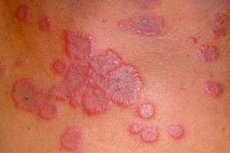Medical expert of the article
New publications
Solar exudative erythema multiforme
Last reviewed: 04.07.2025

All iLive content is medically reviewed or fact checked to ensure as much factual accuracy as possible.
We have strict sourcing guidelines and only link to reputable media sites, academic research institutions and, whenever possible, medically peer reviewed studies. Note that the numbers in parentheses ([1], [2], etc.) are clickable links to these studies.
If you feel that any of our content is inaccurate, out-of-date, or otherwise questionable, please select it and press Ctrl + Enter.

Causes of solar exudative erythema multiforme.
Symptoms of solar exudative erythema multiforme.
The disease mainly occurs in spring and summer. In most cases, hyperemic edematous spots or nodules appear on exposed areas (face, neck, outer sides of arms and legs). Elements (mainly plaques) 0.5-1.5 cm in size tend to grow peripherally, rise slightly above the skin, and have a round or oval shape. The center of the elements is bluish-pink, and the circumference is pink-red. If vesicular elements appear, they contain serous and sometimes hemorrhagic fluid. The vesicle cover quickly bursts, erosions form, their surface is covered with a hemorrhagic and yellowish-gray crust. Itching and burning are felt in the lesions.
Solar erythema multiforme exudative erythema is often combined with polymorphic photodermatosis, solar erythema and other photodermatoses.
What do need to examine?
How to examine?
Differential diagnosis
Solar erythema multiforme exudative should be distinguished from simple erythema multiforme exudative, dermatitis herpitiformis, pemphigus, and sulfanilamide erythema.
 [ 11 ]
[ 11 ]
Treatment of solar exudative erythema multiforme.
Vitamins B1, B2, B12, PP, C, salicylic acid, hyposensitizing, antihistamine and antipyretic drugs, tranquilizers are used in treatment. Hormonal creams or ointments are applied to the skin. Patients are advised to follow a diet, protect themselves from sunlight and use sunscreens.

